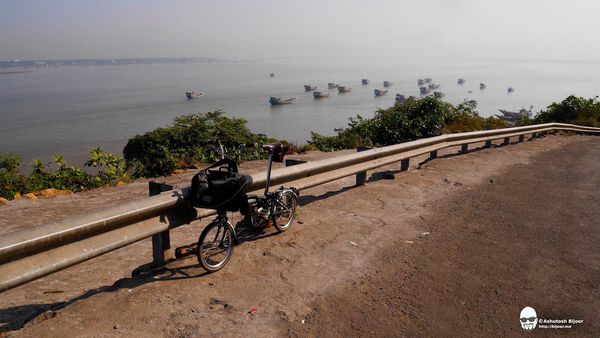Business Travel on a Brompton Bicycle - East Coast, US
The Brompton folding bicycle has become a constant, faithful travel companion for my business trips. On a recent two week trip to the east coast with visits to Philadelphia, New Jersey and Washington DC, I enjoyed a combination of commuting during the week and longer weekend cycling trips in these cities.
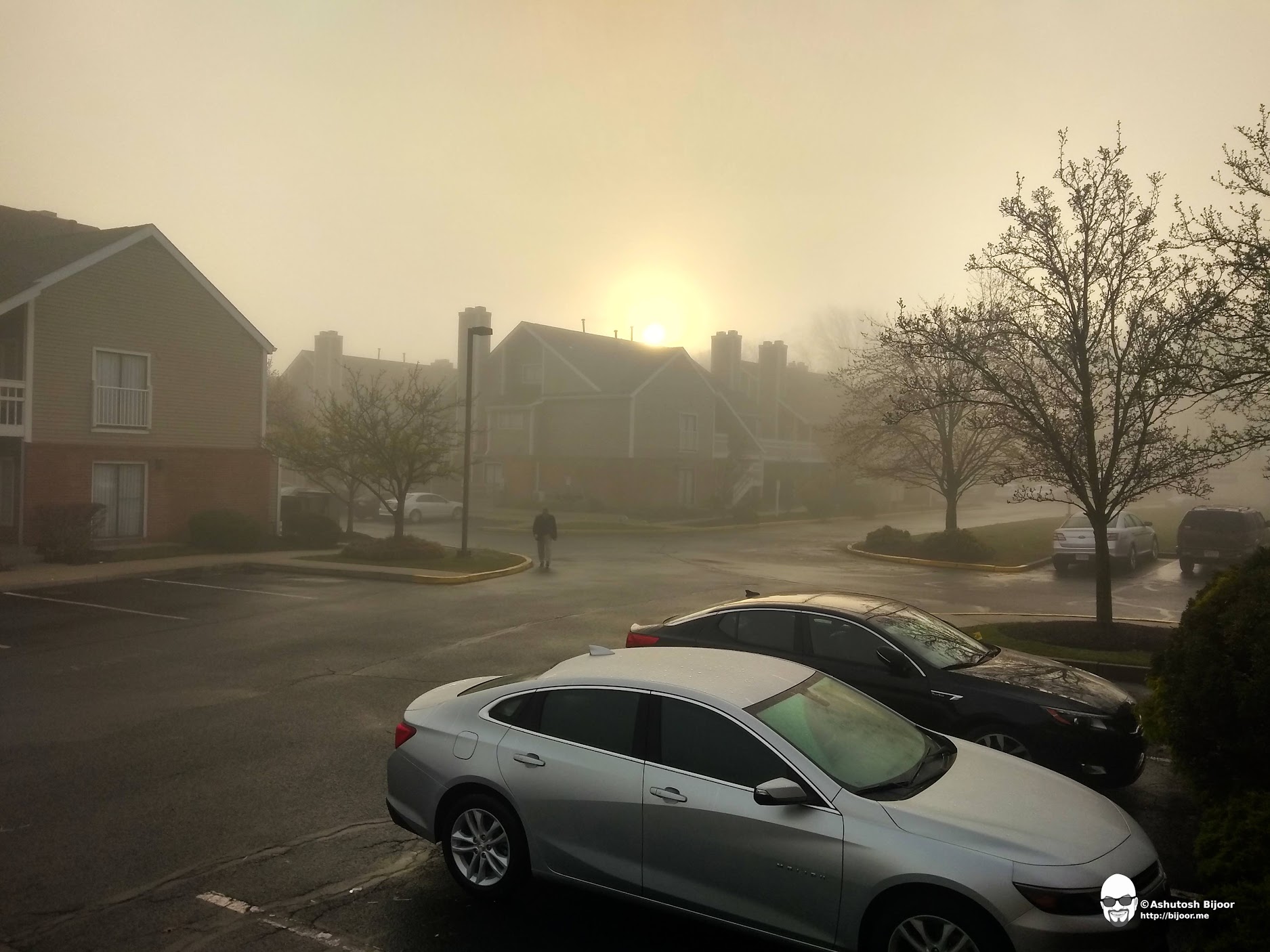
I landed in Philadelphia after a 2 day workshop in Los Angeles to be greeted by this dreary weather. I had another back to back workshop in Philadelphia, and was not looking forward to cycling to work in the rain or snow.
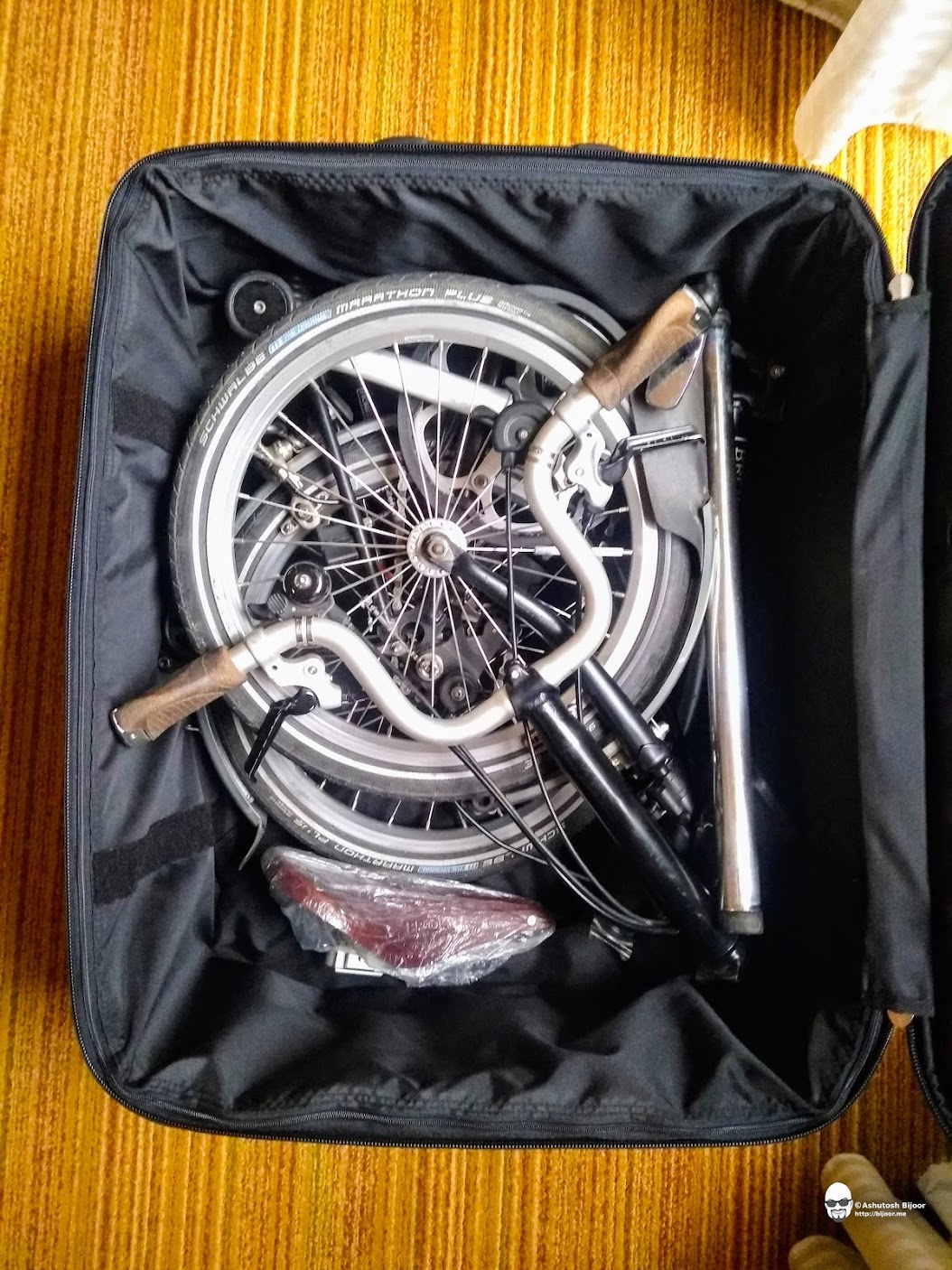
I unpacked the bicycle, hoping that the weather would be kind enough to let me use it.

I rode from the hotel to the nearest subway station to take the train to the city, then rode the last few miles by bicycle. Notice the shower cap protecting my leather saddle :)
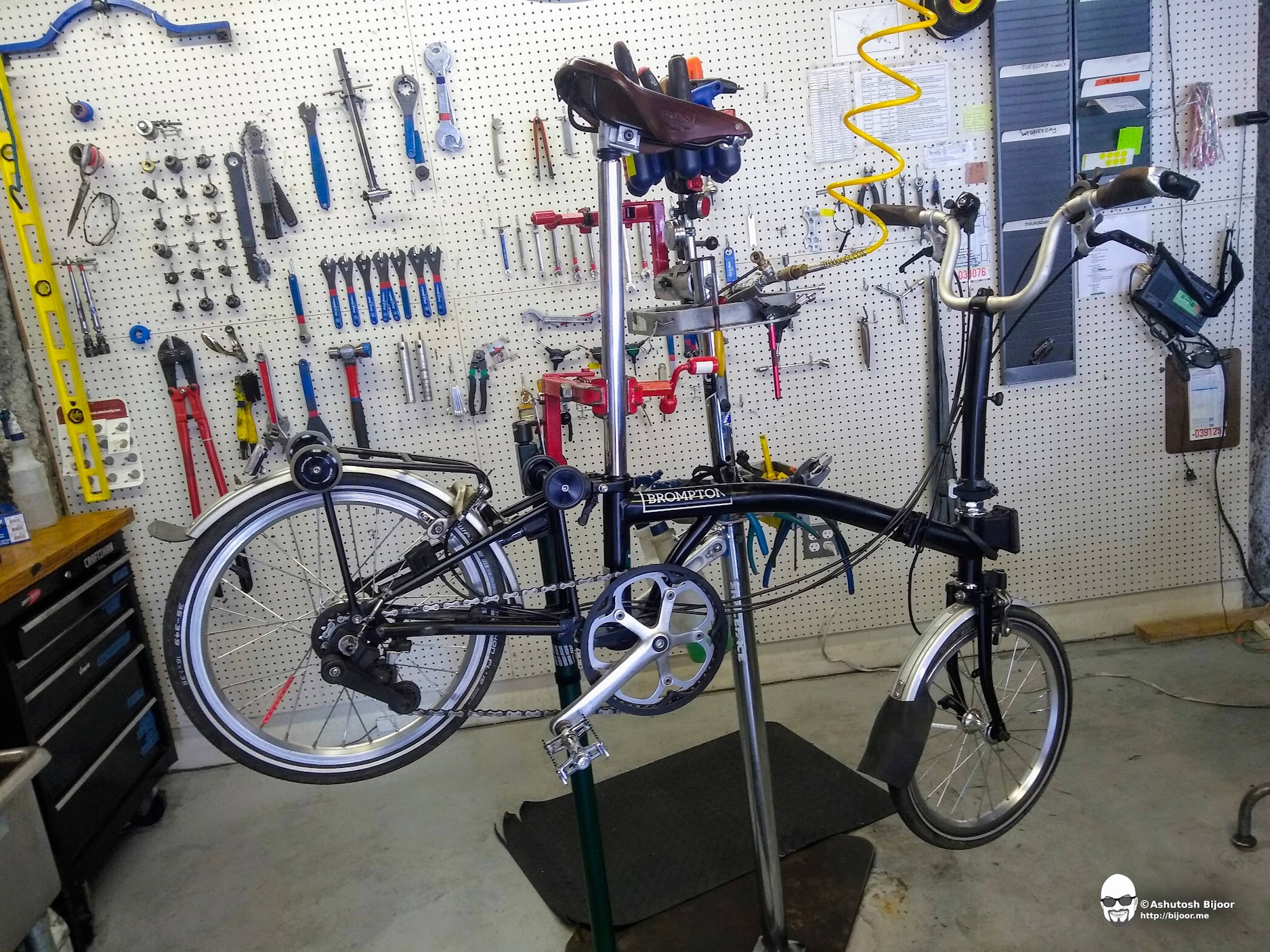
On Friday, after work I visited Trophy Bikes, the local Brompton dealer where I had made some friends with Mike 'McGet', the owner, Mike the Greek who had helped me on my previous visits to replace my bottom bracked, and Zach.
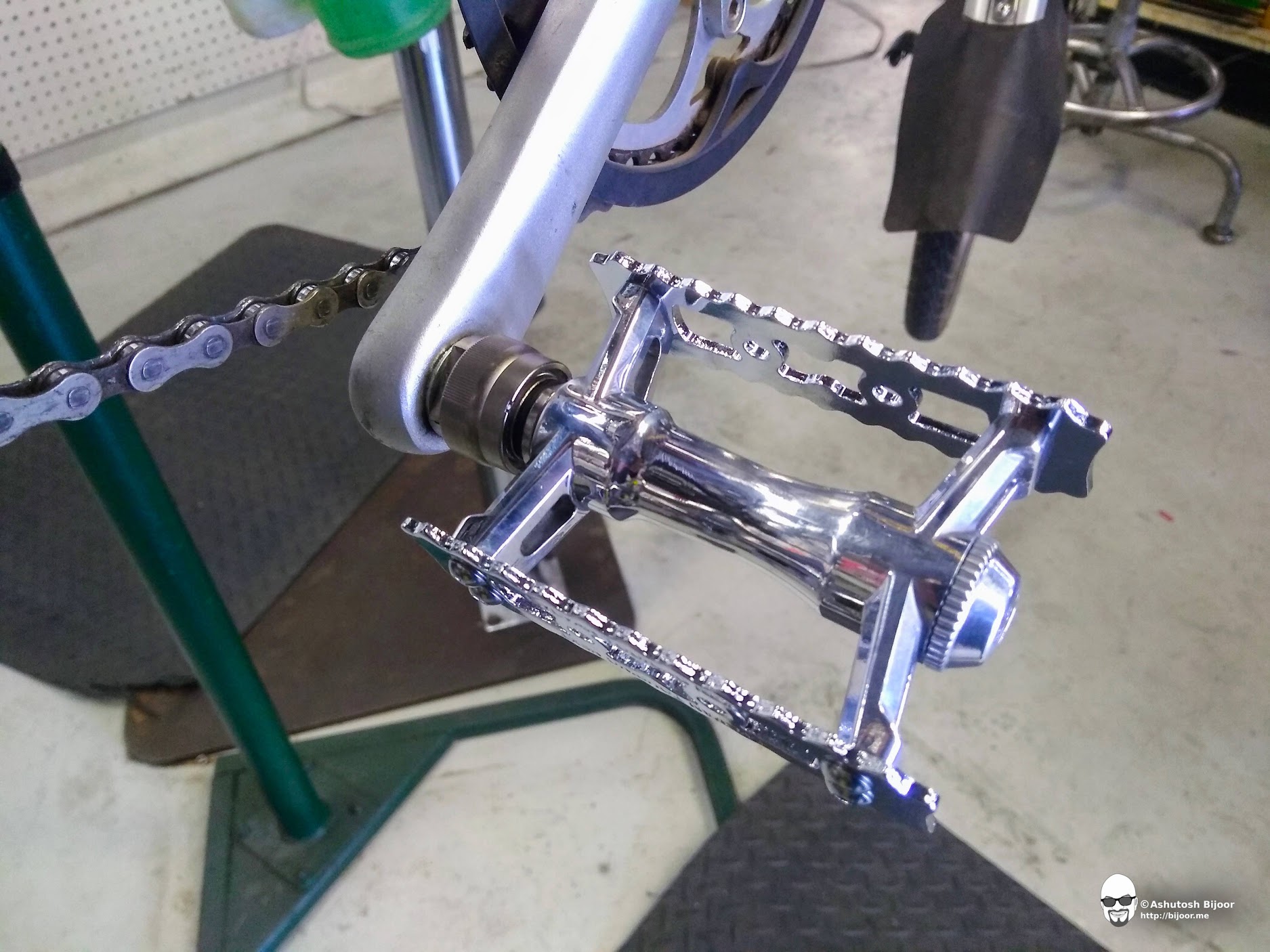
This time's visit was to put on these brand new removable MKS Ezy Superior pedals! Amazing innovation - a simple mechanism that allows pedals to be removed when transporting or storing the bike - especially useful when I'm carrying the bike in the bag on flights.

On the way back to the hotel from the station, I stopped for a coffee and yummy banana cake at this quaint little bakery in Haddonfield called Indulgence Cupcakery. The weather was still quite grey, and I had to use my headlights to safely reach the hotel.
It was the weekend rides that were more interesting. This map outlines the four rides I did on the two weekends during my visit.
The following sections describe these rides in more detail.
- Cycling on the Schyulkill River Trail
- Visit to Strasburg - Train Town and the Amish
- The Cherry Blossom Ride in Washington DC
- Last Ride along Cooper River to Walmart
Cycling on the Schyulkill River Trail
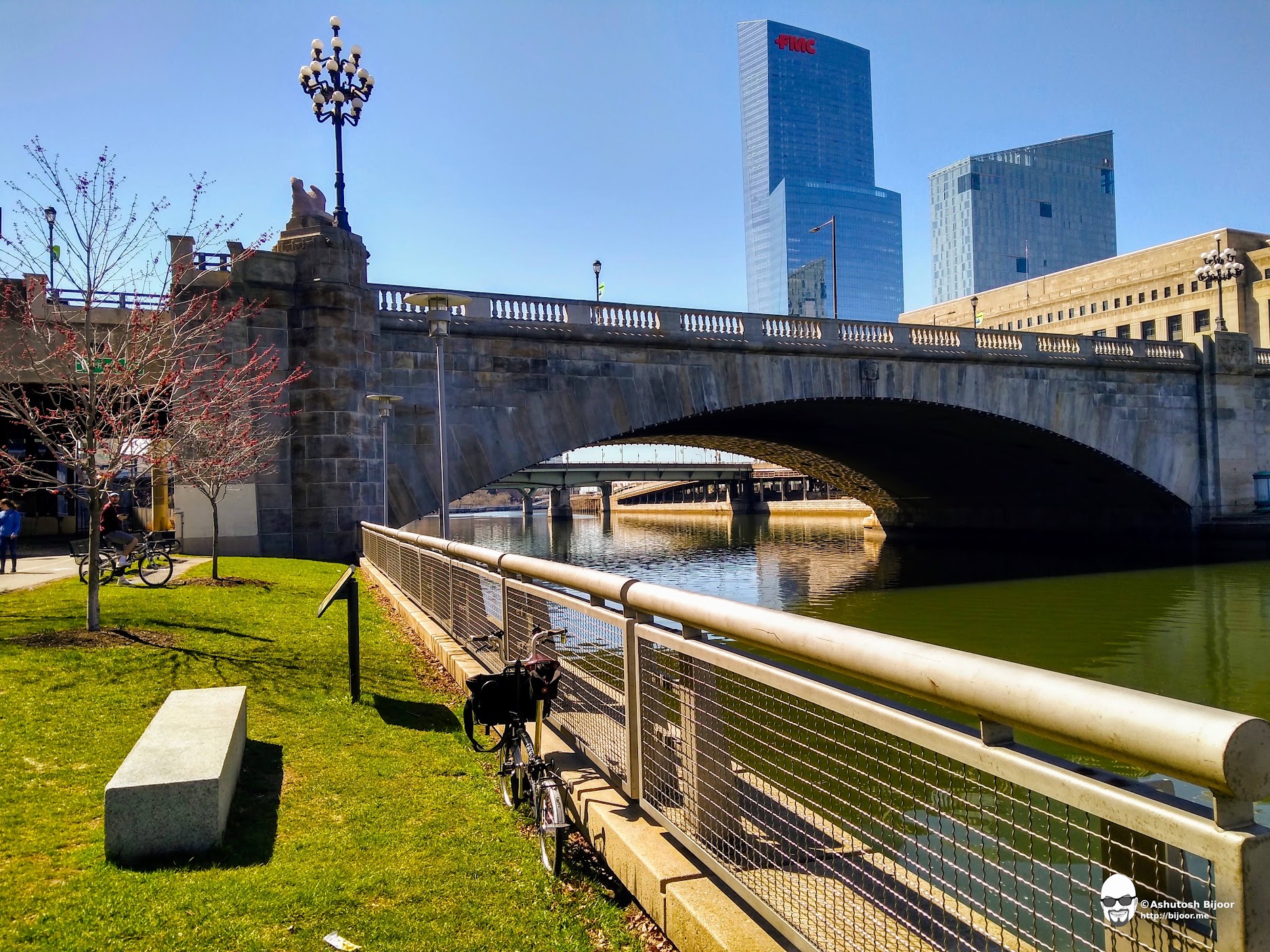
Fortunately, the skies cleared up on the weekend, and I grabbed the opportunity to ride from the Schyulkill River Park in downtown Philadelphia, northwards along the trail that follows the river till the Valley Forge National Historical Park - a beautiful ride of about 60 km (37 miles)
A brief halt at the Philadelphia Museum of Art, that is perched on a small hill that overlooks the river.
The Ellen Phillips Samuel Memorial located further north includes three terraces and seventeen sculptures. Ellen Phillips Samuel was a member of the Fairmount Park Art Association and a supporter of many cultural activities in Philadelphia. When she died in 1913, she left the bulk of her estate in trust to the Art Association, specifying that the income be used to create a series of sculptural monuments “emblematic of the history of America.” (ref)
At the river bank near the Reisman Halterman Memorial Garden are five bridges juxtaposed behind each other - two railway bridges and the two branches of Route 1 highway. If you look carefully, you will see Falls bridge through them at a distance.
I took a brief drinks break at this bench overlooking the river. I considered myself really lucky to be able to get such great weather on the weekend!
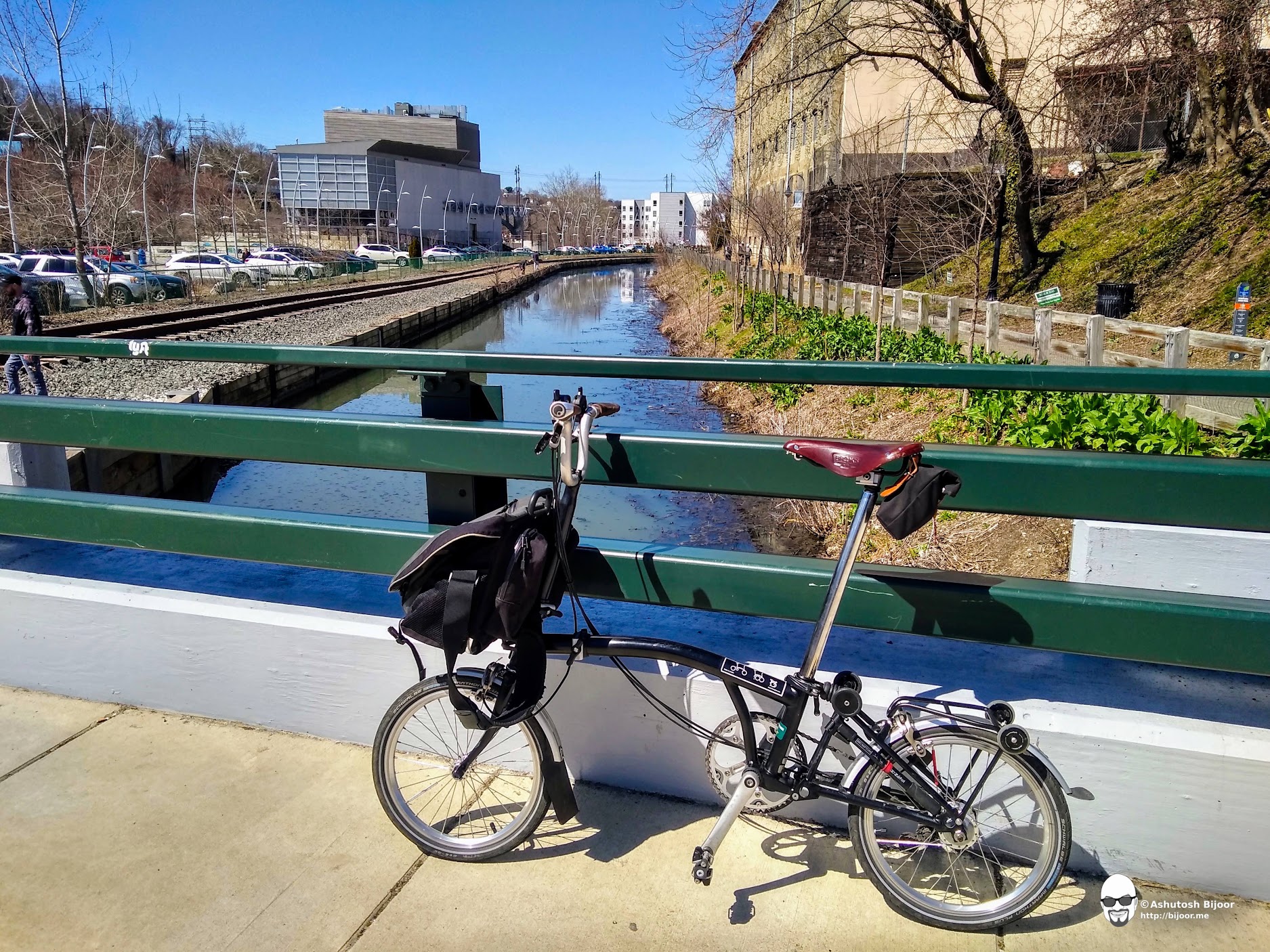
The trail branches into two paths - the Wissahickon Bike Trail branches north from the river along the Wissahickon Creek, and the Schyulkill River Trail continues along Main Street that runs parallel to the river till the Lock Street junction where the trail meets the Manayunk Canal.
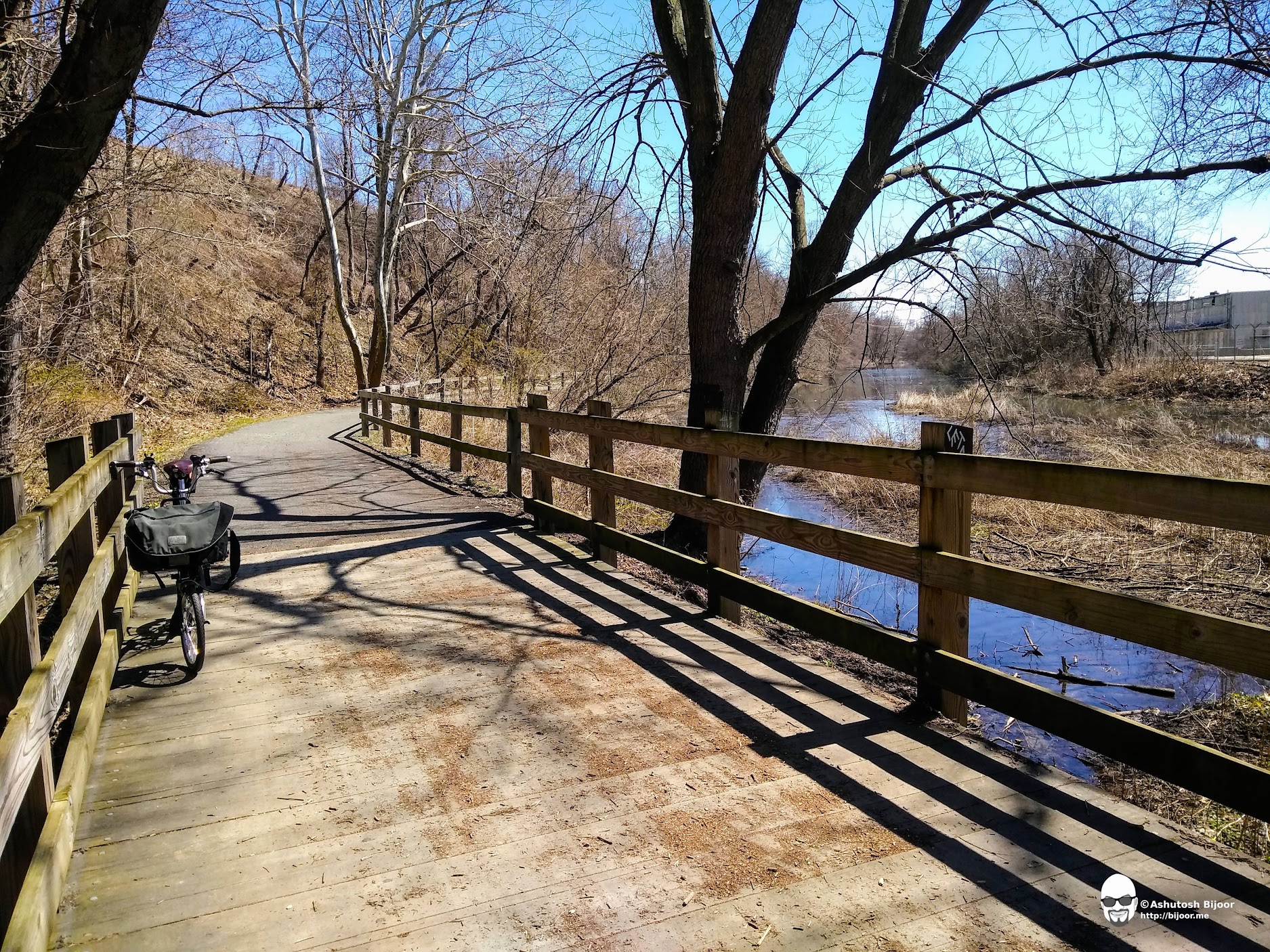
The canal joins the river at the Lock 68 Sluice Gates just before the Flat Rock Dam.

At the dam, I waited to watch a flock of ducks splashing about in the water in the canal, while the dam gushed in the background.
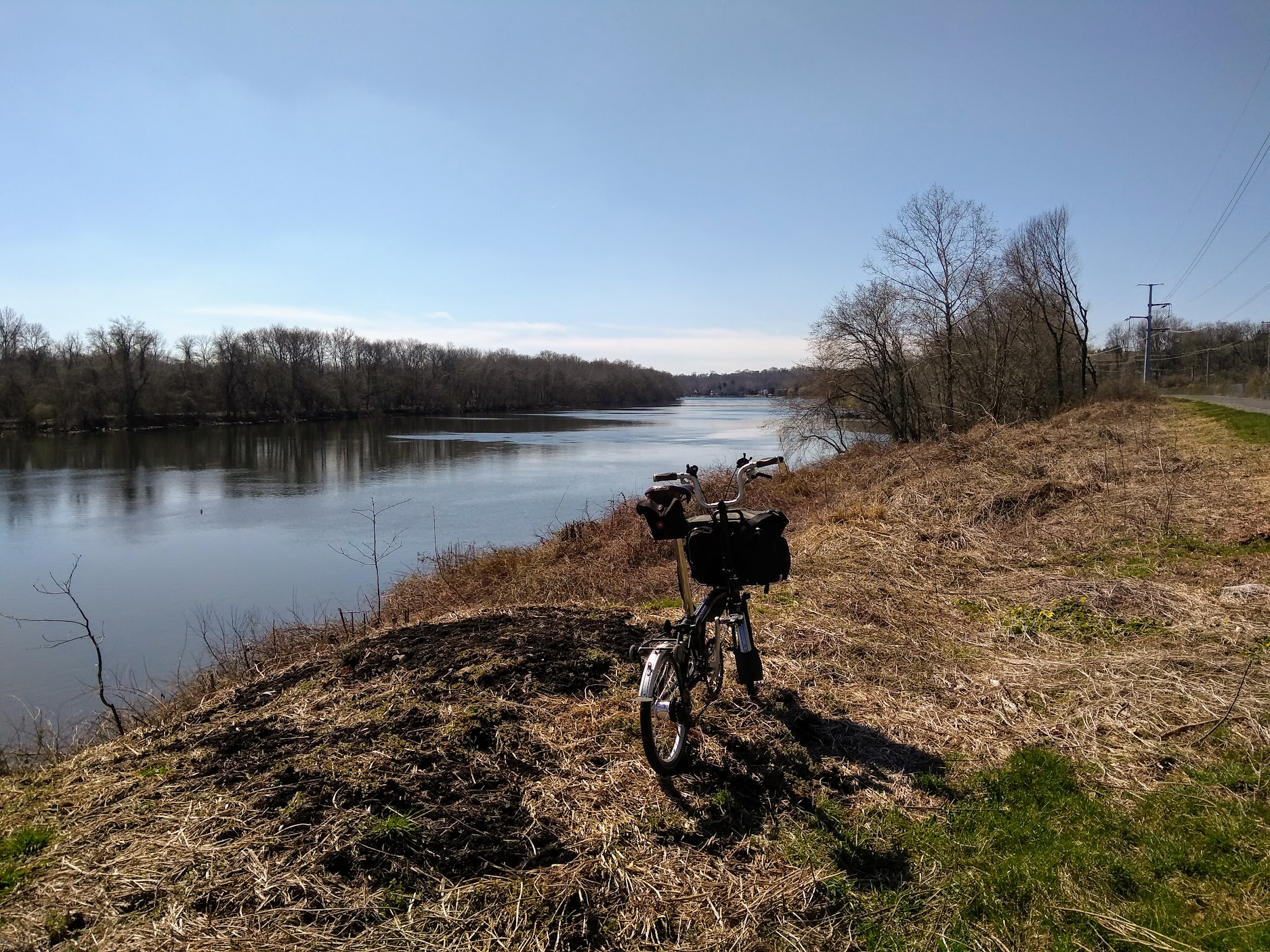
Due to the dam, the river is in full swell upstream, and it widens considerably. The river bends almost 90 degrees near Spring Mill, and turns westwards. Not too far from the bend is located a quaint cafe and bike shop aptly named River Bend Cycles, where I stopped to have a quick bite and drink before proceeding ahead.
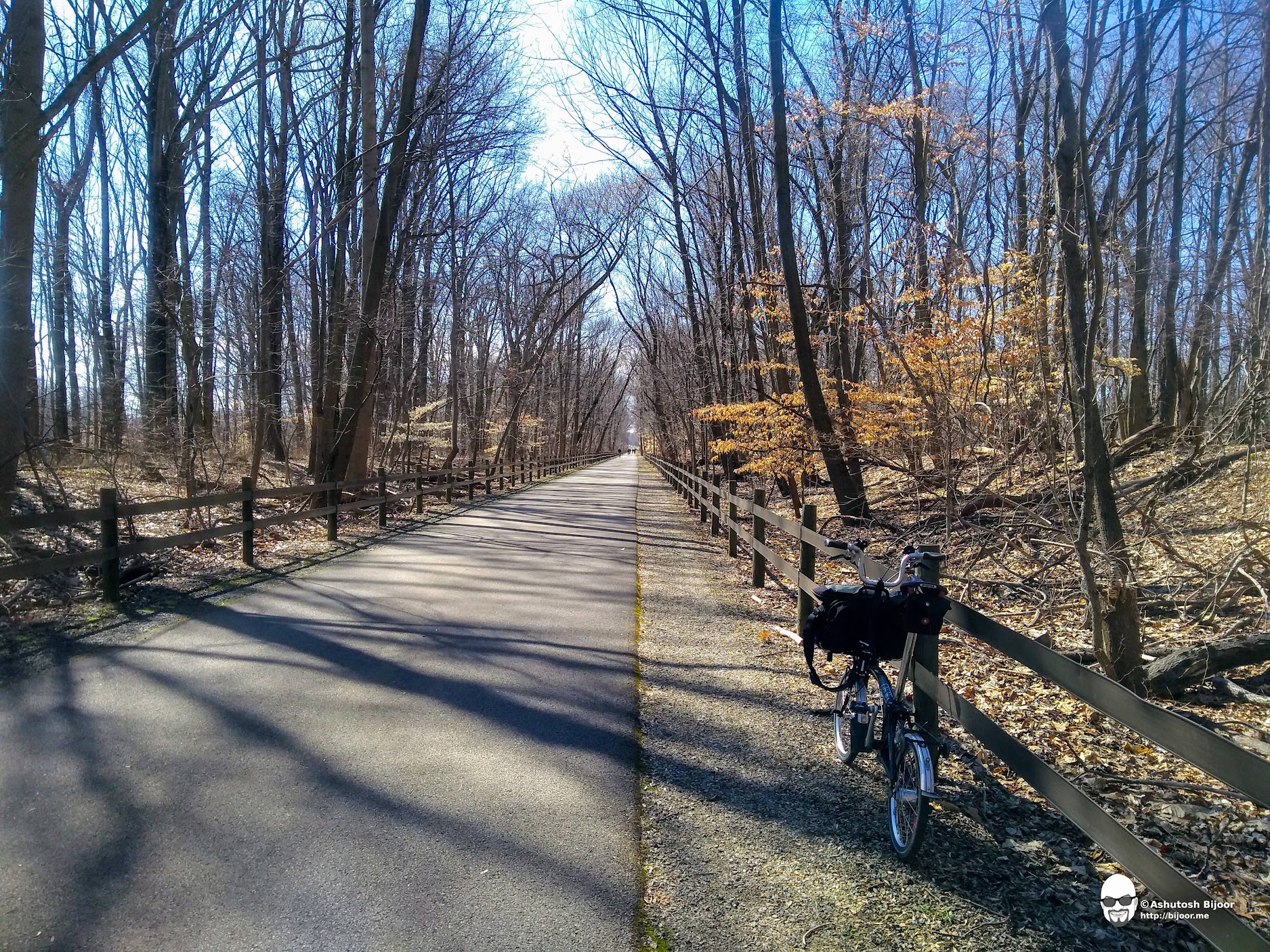
The trail occupies a former railroad right-of-way originally owned by the mighty Pennsylvania Railroad (PRR). The corridor was completed in the 1880s and offered the PRR a through-route from Philadelphia to Wilkes-Barre, to serve the rich seams of anthracite coal found there. However, demand for anthracite coal waned considerably after World War II as a heating source. The line’s fortunes, and the many railroads that depended upon coal as a vital source of revenue also declined. (ref)
I ended my ride at the Valley Forge National Historic Park. I lazed around enjoying the sounds of the river, before making the inevitable return to the city.
Visit to Strasburg - Train Town and Amish Village
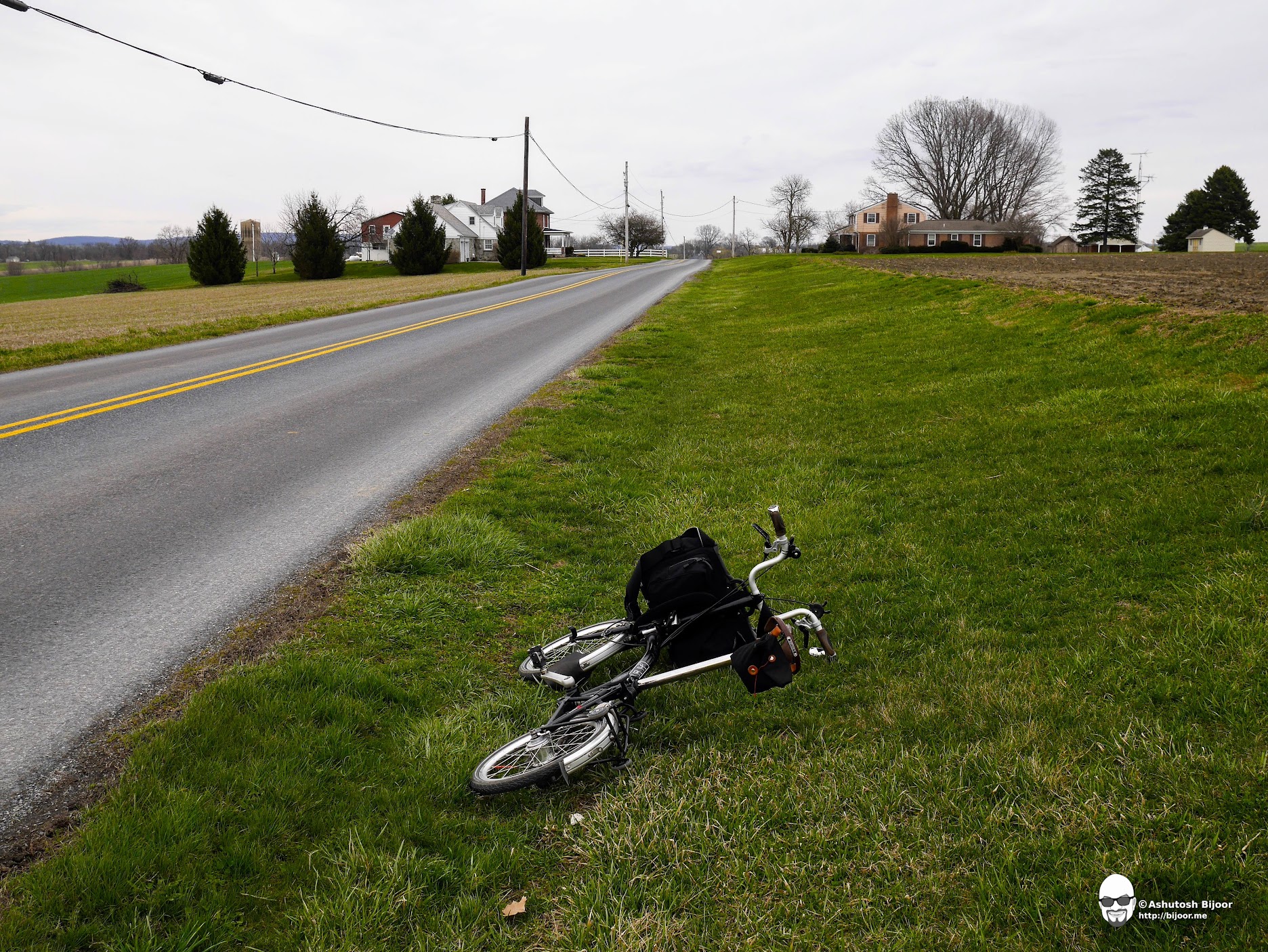
On Sunday of the same weekend, I accompanied my cousin and her grandchildren to visit Strasburg. Strasburg is a small town that is known for two major attractions - the historic railways and the Amish. The countryside around Strasburg has several farms that are homes of the Amish.
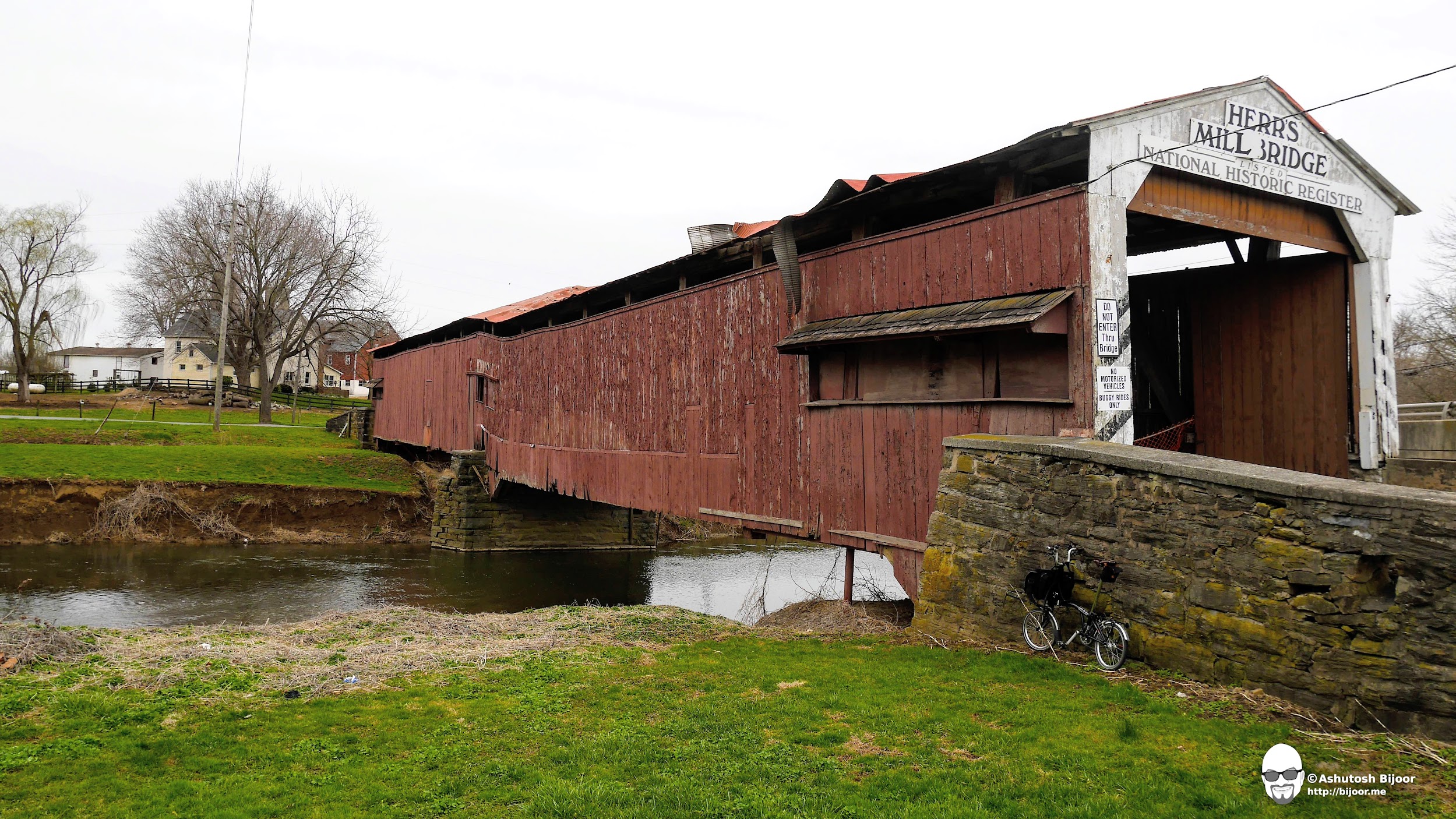
Another unique attraction in the entire Lancaster county in which Strasburg lies are the covered bridges. From the 1820s to 1900 there were about 1500 covered bridges built in Pennsylvania. Today 219 bridges remain in 40 counties. Lancaster County has more than any other county (ref).
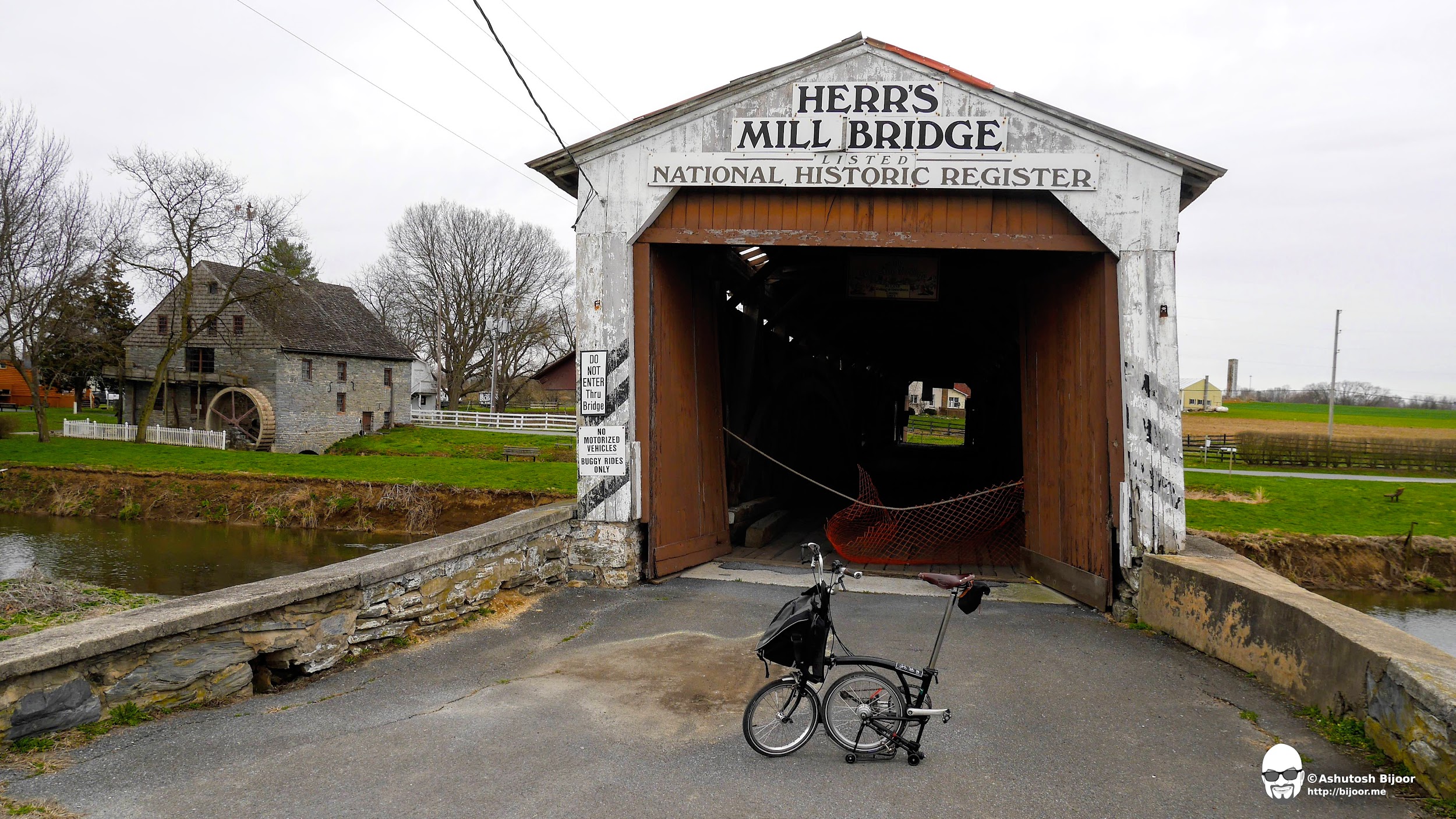
The Herr's Mill Covered Bridge spans Pequea Creek. It is also sometimes known as Soudersburg Bridge. The bridge has a double span, wooden, double Burr arch trusses design. It is painted red on the outside, the traditional color of Lancaster County covered bridges. Both approaches to the bridge are painted in the traditional white color. It is now on the private property of the Mill Bridge Village Camping Resort (ref).
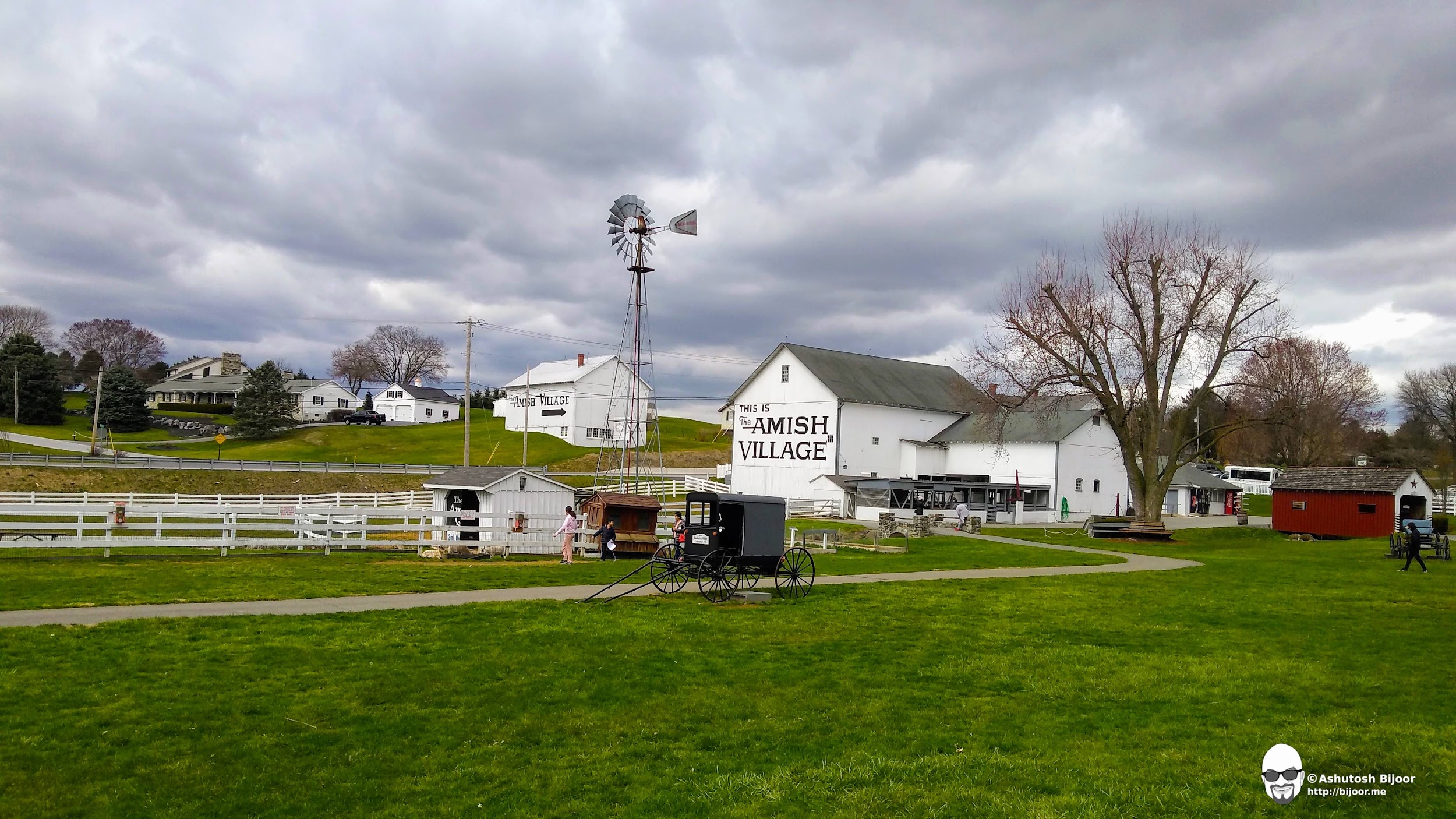
I visited the Amish Village, an exhibition consisting of a home, farm and various artifacts that are typical of the Amish way of life. The Amish trace their origin back to the Protestant Reformation in Europe, where there was an emphasis on returning to the purity of the New Testament church. One group of reformers who rejected the popular concept of infant baptism, and became known as Anabaptists (ref). The Anabaptists split into two groups - the Mennonites and the Amish (ref).
The Amish use horse buggies like the one in this photograph. I passed several while cycling through the coutryside. Although the Amish religion allows the Amish people to ride in automobiles, as well as buses and trains, they are forbidden to own one. In fact, of all the worldly possessions available, the car is considered the most dangerous to the unity of the community and the purity of the culture (ref). Despite their old world look, most of these buggies have been engineered using modern technology. They have hydraulic disc or drum brakes. Ninety-nine percent of buggies are built with a dash—a console on the front panel - and in that switch box is all the switches you need - headlights, taillights, interior lights, and a turn signal switch. The main body is fiberglass. A new technology is thermally modified wood - they just bake the moisture out of it, and then it's stabilized and real hard to rot. (ref).
So the buggy is basically a modern, environmentally safe transportation alternative... much like the bicycle!
The most popular choices of horses for Amish transportation are the black, bay and chestnut Standardbred horses that failed to “make the cut” at tracks in Indiana, Ohio, and Michigan. Although their speed is not enough to win purses in competitive racing, these good-natured and versatile animals are ideally trained to pull a buggy or farm cart over long distances in heavy traffic. With their calm disposition, they seldom startle at a passing truck, while their long legs and powerful build eat up the miles effortlessly (ref)
This is a model of an Amish school. School for Old Order Amish and Mennonites is only a part of the learning necessary for preparation for the adult world. Children have formal schooling in such one-room schools to 8th grade and then have a structured learning program supervised by their parents. Classes in the one-room Amish schools are conducted in English, and the children learn English when they go to school (ref).
The Amish are refereed to as “Plain People” primarily because of the way they dress; very plainly. There are never any patterns on any of their clothing and all of the men’s suits, and the women’s dresses, are all plain colored. The rules require that only solid colors can be used and the colors typically consist of black, blue, burgundy, brown, purple, or green (ref).
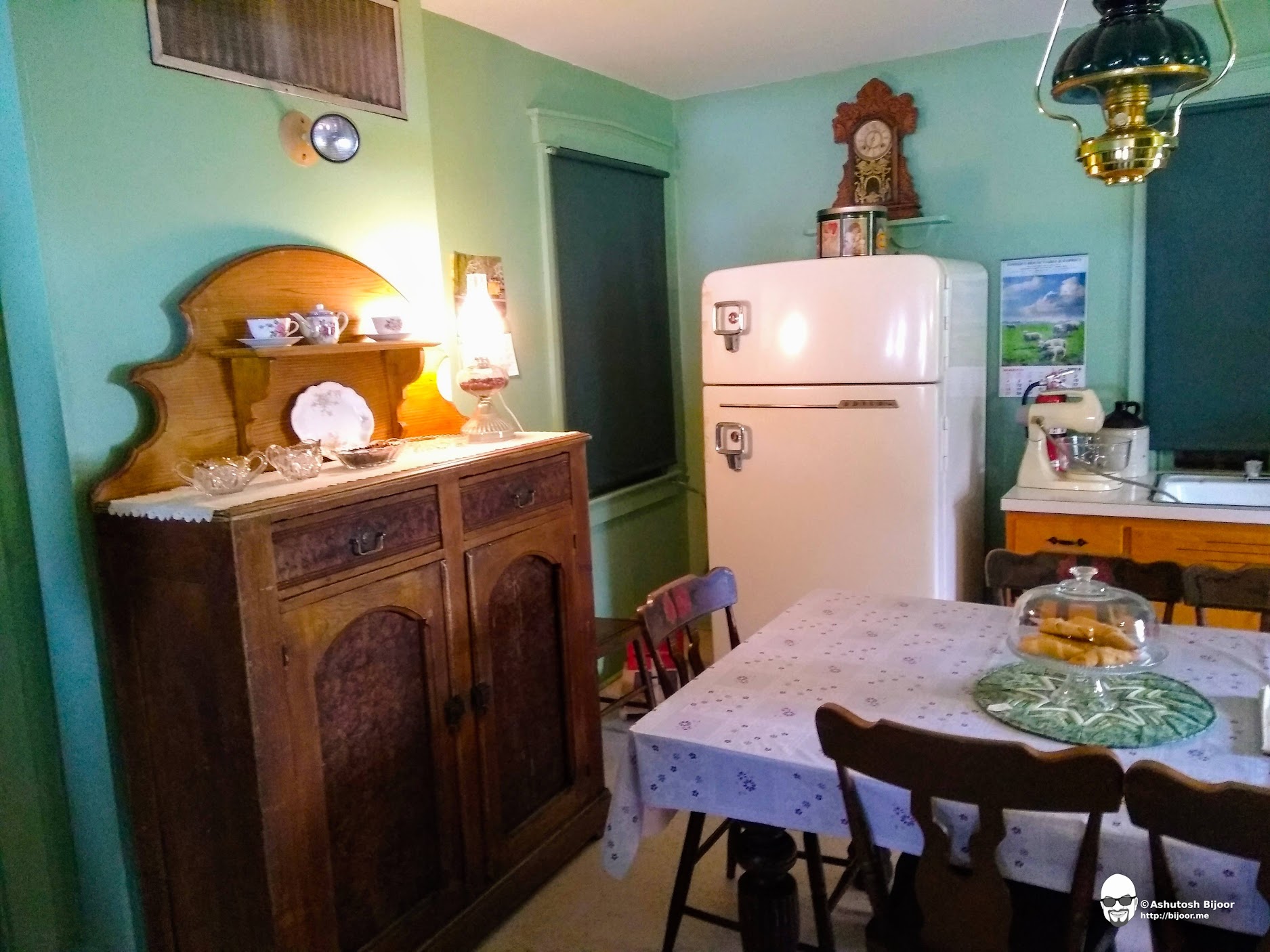
Amish homes are usually large with two stories since many Amish families consist of six or seven children. The homes tend to be plain and are usually painted white, green, blue or brown which are the colors of nature. Everything within the house is functional. To preserve the religious value prohibiting pride and vanity, pictures and photographs are not hung on the walls for decoration (ref).
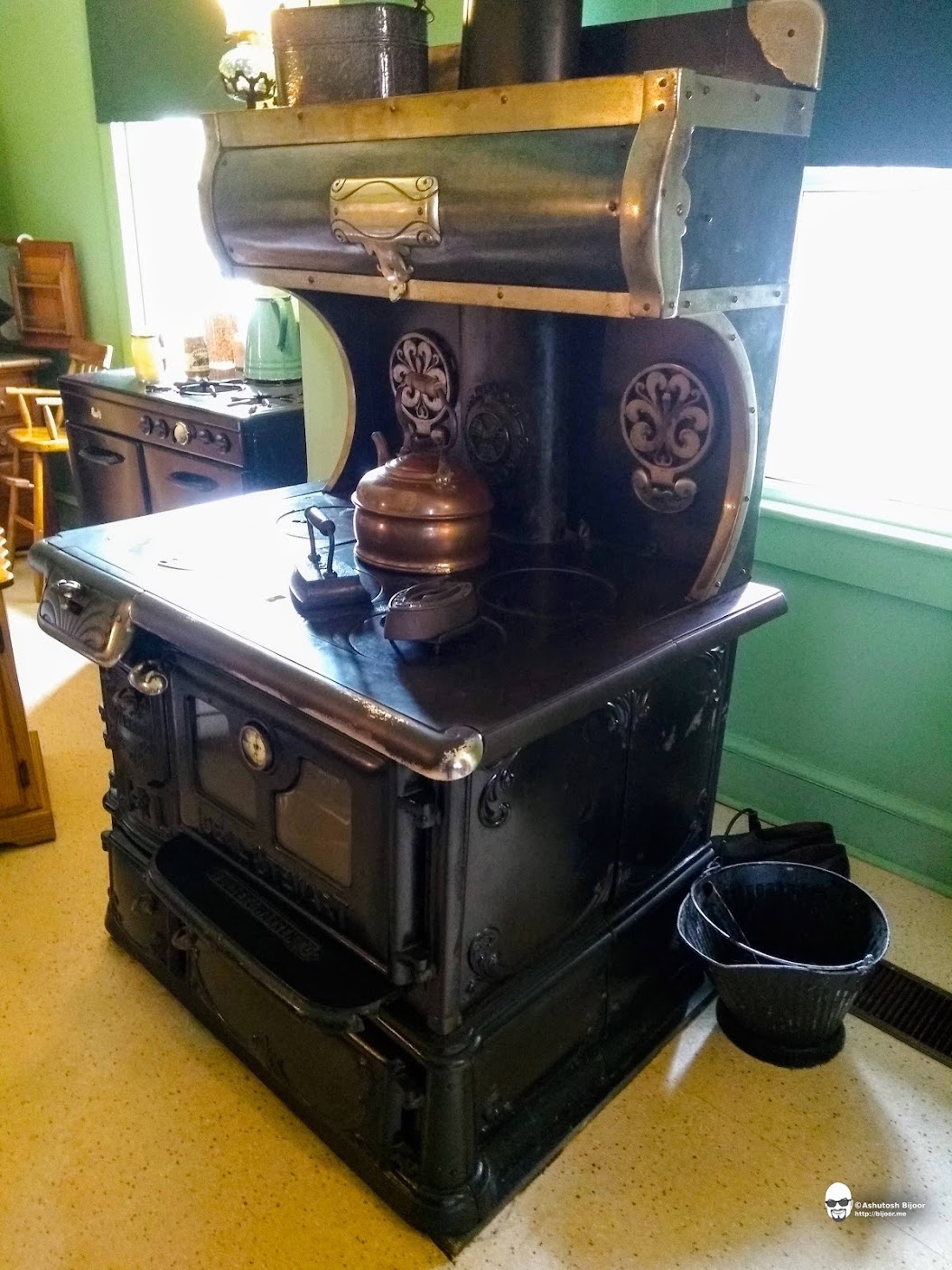
As part of the Ordnung and the tenets of the Amish religion, electricity is not used within Amish houses. Instead, alternate means of energy are used. For instance, in Amish kitchens refrigerators and stoves are often powered by various types of natural, propane or bottled gas or kerosene (ref).

Amish furniture is well-made and sturdy but modest in design. Curtains, shades, and quilts may feature colorful designs but are also modest and simple. When designs are used, typical motifs tend to involve depictions of nature such as doves, roses and trees
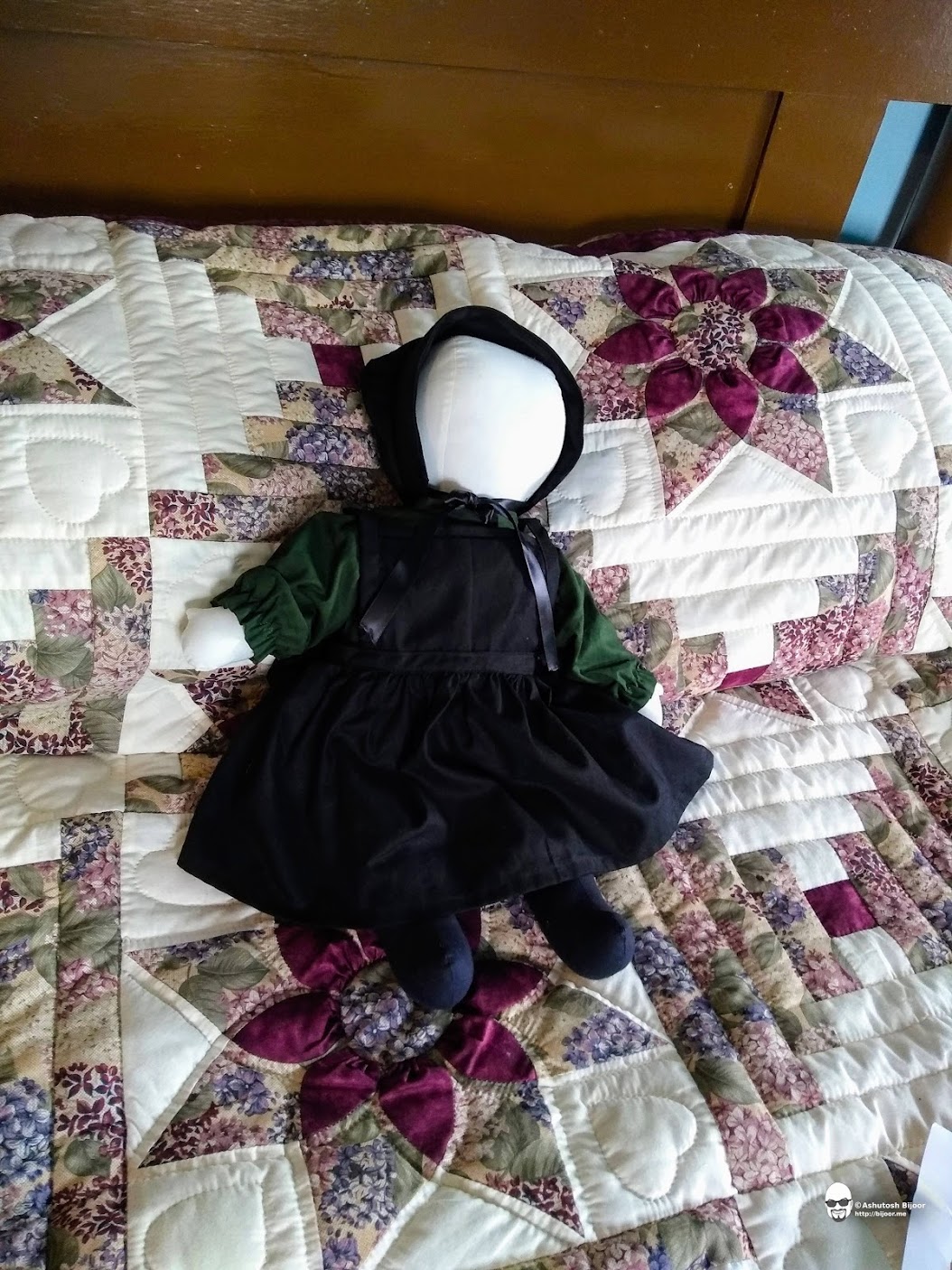
The Amish hold humility as a highly-cherished value and view pride as a threat to community harmony. Because items such as personal photographs can accentuate individuality and call attention to one's self, they are prohibited from the home. Moreover, the Amish believe that photographs in which they can be recognized violate the Biblical commandment, "Thou shalt not make unto thyself a graven image." They want to be remembered by the lives they lived and the examples they left, not by physical appearance (ref). Due to this same principle, even the dolls that are made for children do not have faces on them.
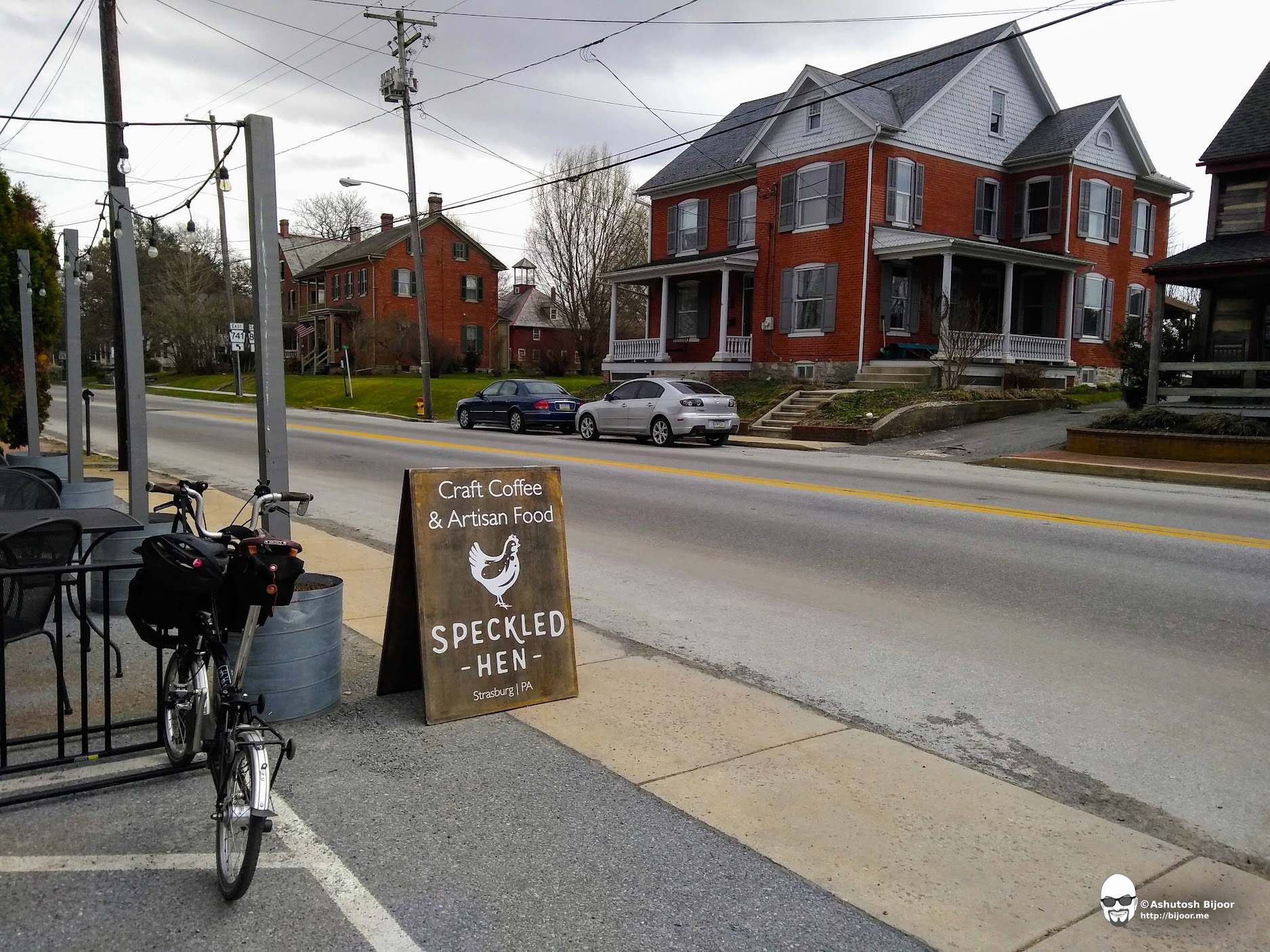
After learning about the Amish way of life at the Amish Village, I was famished, and found this quaint restaurant on the Main Street called The Speckled Hen. The Speckled Hen features craft coffee and artisan food. Serving a delicious array of breakfast, lunch, and dinner options; focusing on foods that are made with the freshest ingredients while partnering with local farmers and purveyors.
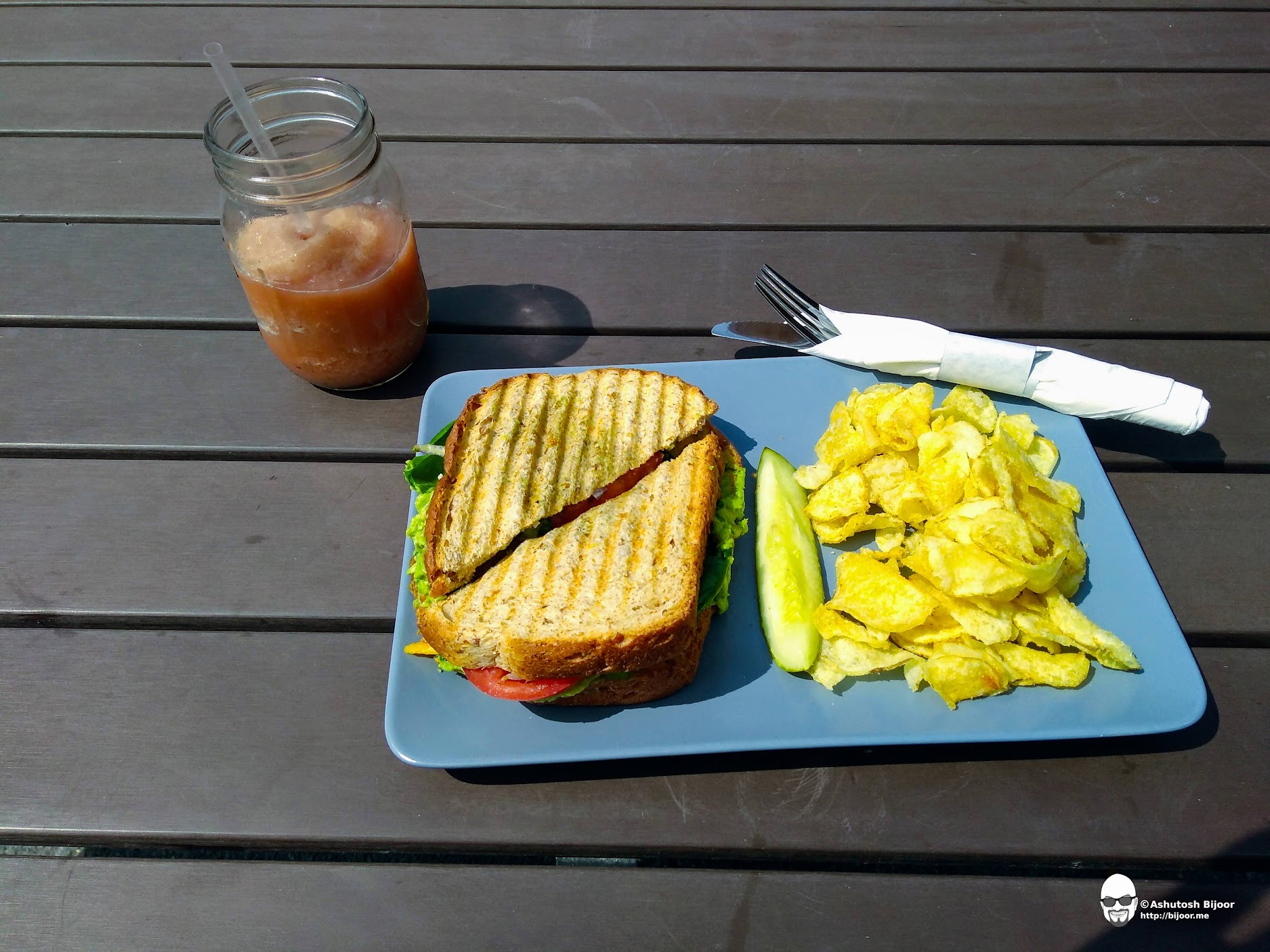
I was tempted to try their coffee, but decided to keep it healthy and ordered a yummy eggplant (my weakness) and avocado sandwich and a smoothie instead.
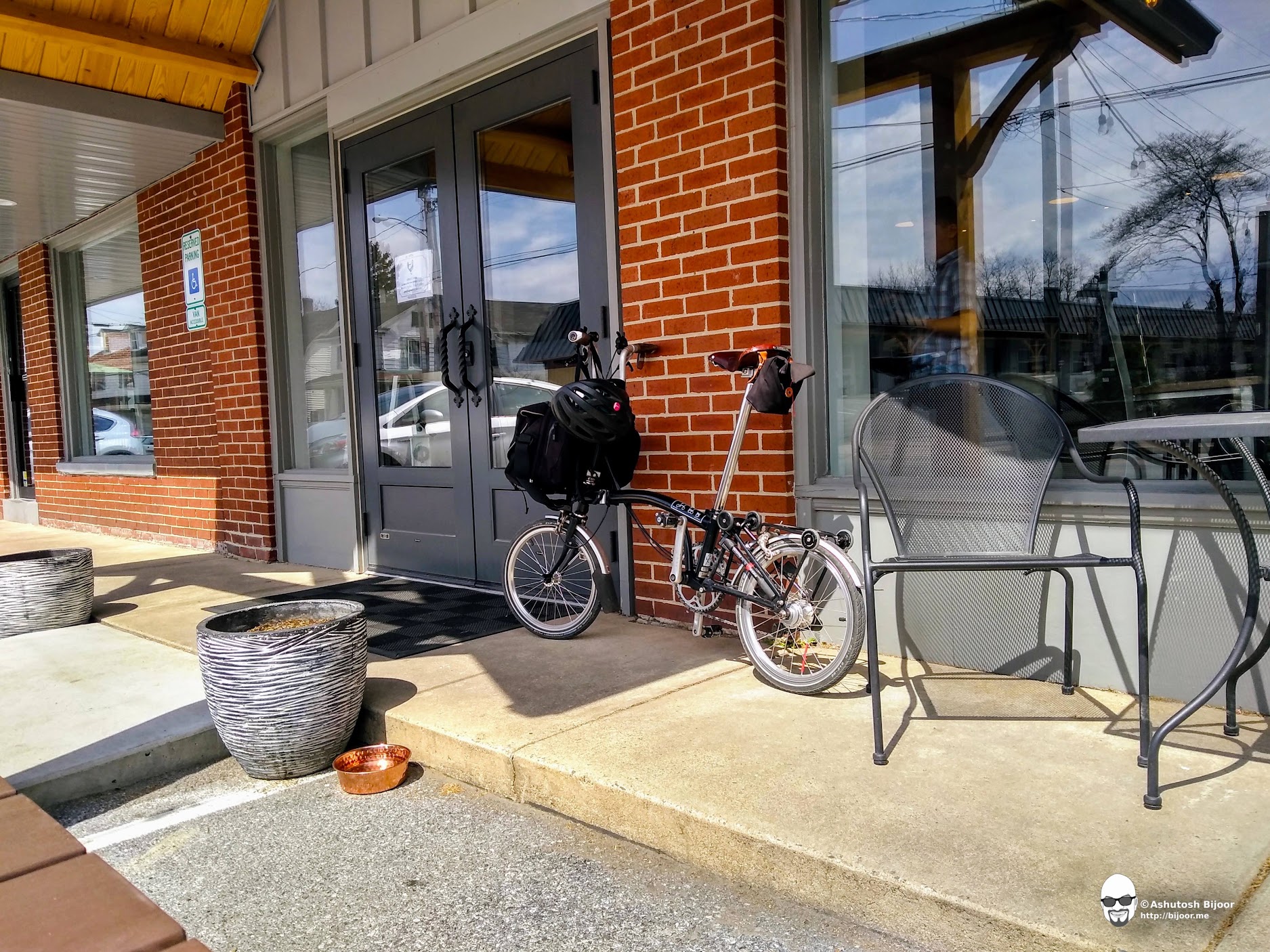
While I was having lunch, the sun had come out and I sat on a wooden table and bench outside, with my bicycle keeping company.

After lunch, I went to the Strasburg Rail Road center where my cousin and her grandchildren were spending the day. The Strasburg Rail Road is the oldest continuously operating railroad in the western hemisphere and the oldest public utility in the Commonwealth of Pennsylvania. Chartered in 1832, the Strasburg Rail Road continues to operate under its original charter and original name (Strasburg Rail Road Company). Located just outside of Strasburg, the heritage railroad offers excursion trains hauled by steam locomotives through the heart of world-famous Pennsylvania Dutch Country (ref)
The train includes the United States' only operational wooden dining car on which visitors may dine while riding. Attractions at the station include the fully operational 15 in (381 mm) gauge Pint-Sized Pufferbelly (Cagney steam-powered ridable miniature railway) a vintage pump car and several c.1930s "cranky cars" along with several gift shops and a cafe (ref)
I also rode with the kids in the Pint-Sized Pufferbelly. Built around 1920, this miniature steam train was originally used at an amusement park at Coney Island, NY (ref)
After the hectic weekend rides, I did a last ride from West Chester to Elwyn to take the train back to Haddonfield and then a short ride back to my hotel.
This is the view of the Delaware river and the lights of the city from the train as I crossed over from Philadelphia to New Jersey.
The Cherry Bloom Ride in Washington DC
The next weekend, the last of my visit was short, for I had to catch the flight back to India on Sunday evening. So on Saturday morning, after a business debrief session with the on-site team, we all decided to drive to Washington DC to see the Cherry Blossoms. I of course took my Brompton folding bicycle with me. It was a chilly, cloudy day, but I did not want to lose a weekend without cycling. So I prepared myself with adequate layers of clothing and warm body ends protection (gloves, woollen socks and cap).
After reaching DC, I accompanied my colleagues to the Pentagon memorial, and then separated from the group and rode over the Arlington Memorial Bridge across the Potomac river to the Potomac Park, where the cherry blossoms were in full bloom!
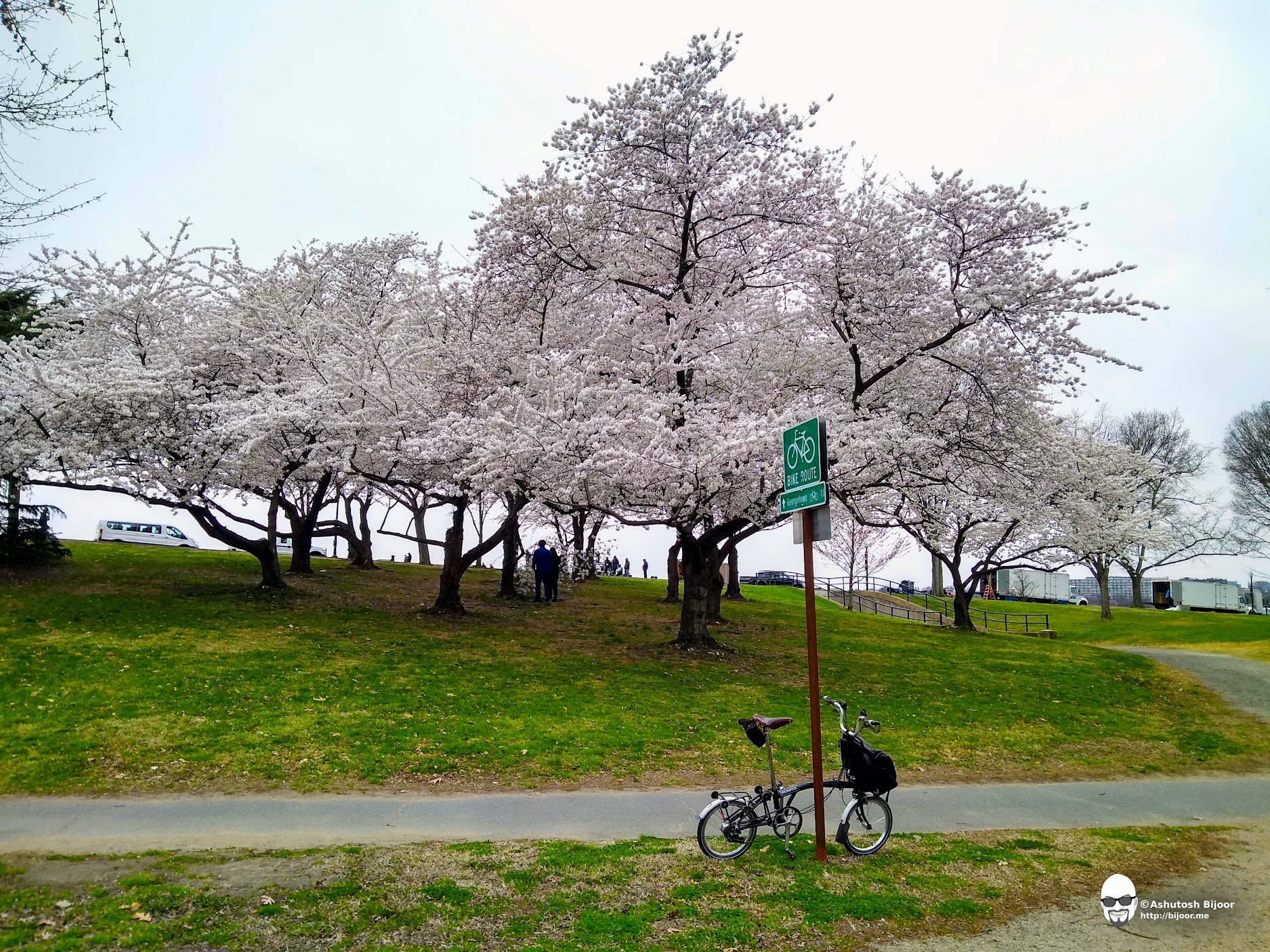
Despite the weather, there were several tourists around and the cherry blossoms were a major attraction. These gardens around the Lincoln memorial were full of blooming cherry trees.
I then joined the Capital Crescent Trail, a rail-trail built upon the former railbed of the 11 mile Georgetown Branch of the B&O Railroad. It is a hard surface trail from Georgetown to Bethesda suitable for walkers, joggers and bikers from Bethesda to Lyttonsville, in western Silver Spring. Seven bridges and two tunnels offer trail users gentle gradients and grade-separated crossings at many major roadways (ref)
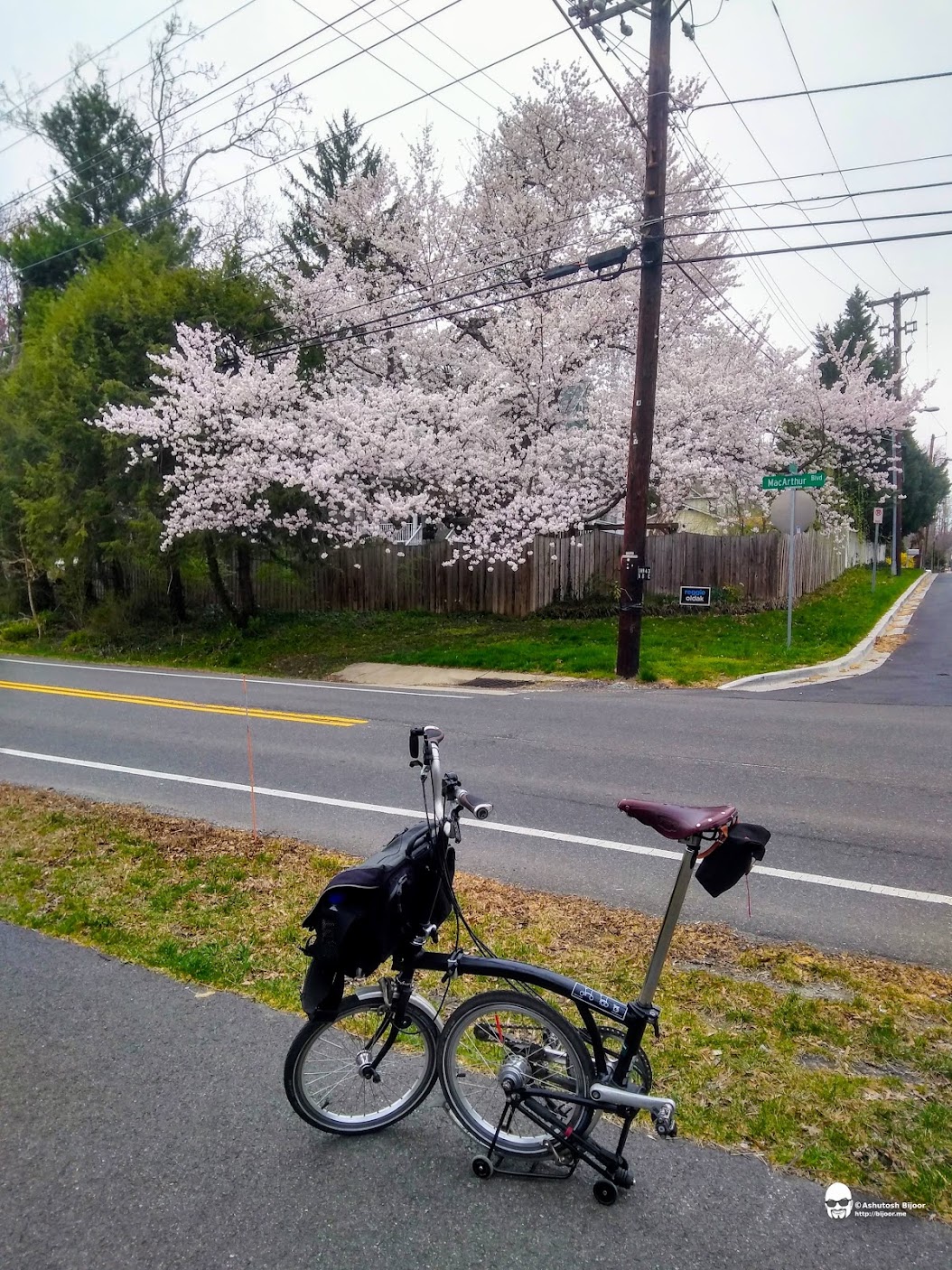
I followed the Capital Crescent trail as it follows the Potomac riverside and then branches away near the Dalecarlia Reservoir to the north with a steep uphill climb. There I left the trail to ride along MacArthur Boulevard. There is a cycling track all along the road, and I rode at a good pace, only to stop to admire the cherry blossoms wherever I could find them.

My destination was further uphill where I was planning to give a surprise visit to my old classmate from college. This street lined with beautiful trees on either side was the culmination of my ride. I was rewarded with a warm welcome and a yummy meal!
Last ride along Cooper River to Walmart
On Sunday morning, I finished all my packing and saw that the sun was out and it was quite pleasant outside. I decided to do one last ride to Walmart to do some last minute shopping.

Instead of taking the straight road to Walmart, I took a slightly round about route via Cooper River. I rode up to Wallworth pond, where I stopped to let the ducks waddle across the road and then proceeded ahead to join the Cooper River.
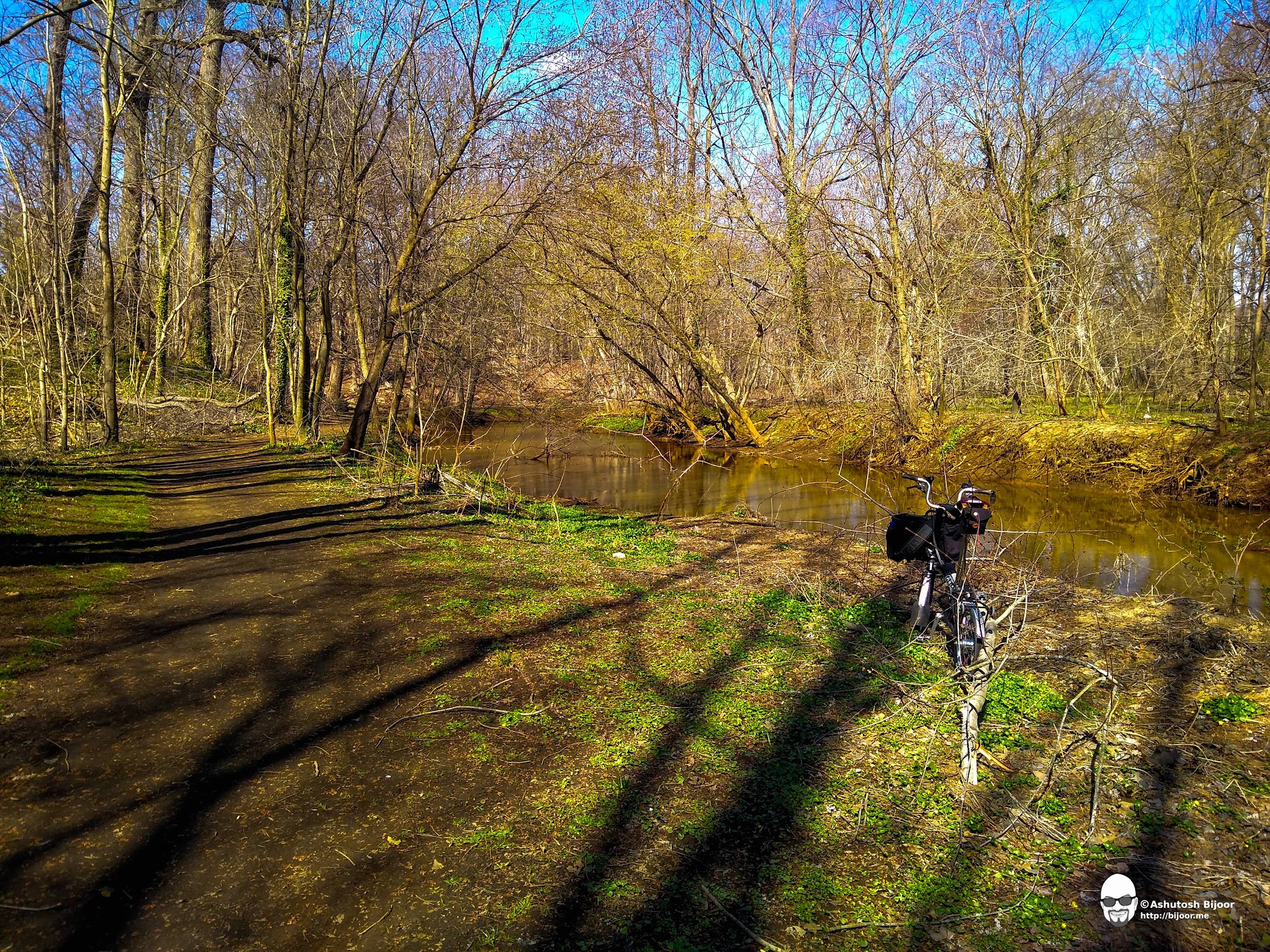
The trail along the river is a small path. I had been this way before last year, and hence knew the way. The temperature was just a perfect 16 degrees Celcius (60 Farenheit) and the sun was casting shadows of the trees all along.
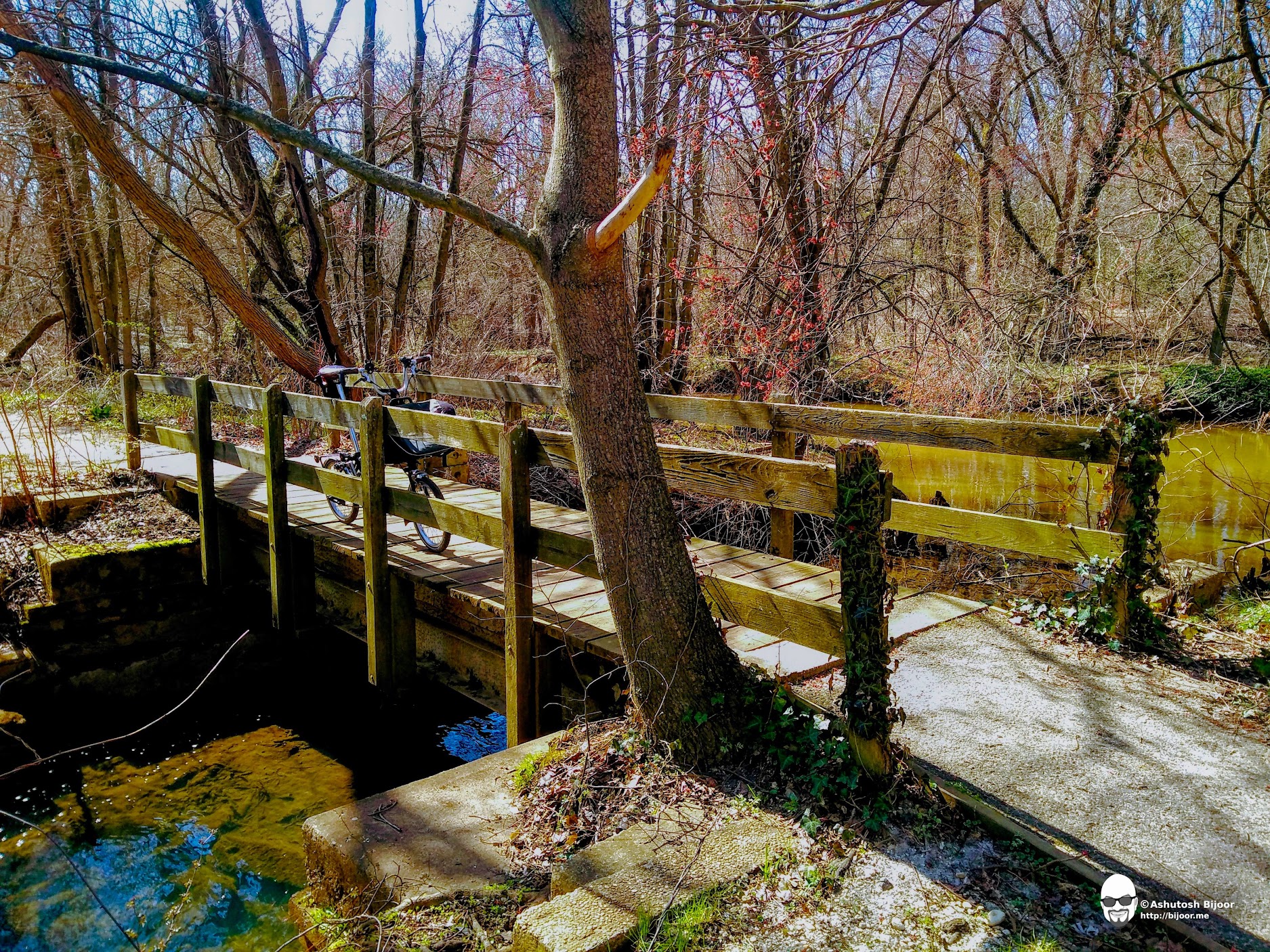
I crossed over this wooden bridge towards Park Boulevard that runs parallel to the river, but continued on the trail next to the river
After crossing over Grove Street, the trail continues on the other side with a better surface.
I stopped a while at this small jetty with a bench - a great location to just sit and read a book... maybe next time. I had to hurry to do my shopping, return to the hotel, check out and rush to the airport!
I managed to do all that and reach the airport in time. However once we boarded the airplane, we had to wait over an hour because there was some technical glitch
So by the time we took off, it was already dark. I saw the lights reflecting in the river as we headed into the sky. This was a short, but fruitful trip! All the business workshops went well, and the weekends gave me an opportunity to enjoy some beautiful cycling rides!




